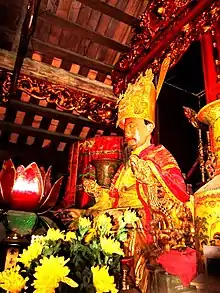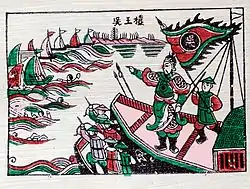Ngô Quyền
Ngô Quyền (Hán tự: 吳權) (March 12 897 – 14 February 944), formally King Ngô, is often referred as First King Ngô, was a warlord and Vietnamese monarch who founded the soreveign kingdom of Annam, ruling from 939–944. He defeated the Southern Han kingdom at the Battle of Bạch Đằng River north of modern Haiphong and ended 1,000 years of Chinese domination dating back to 111 BC under the Han dynasty and consolidated the Vietnamese independence.[1] A central district in modern Haiphong is named after him. [2]
| Ngô Quyền | |||||
|---|---|---|---|---|---|
| King of Jinghai | |||||
 Ngô Quyền's statue in Hai Phong | |||||
| Grand Prince of autonomous oblast Tĩnh Hải quân | |||||
| Reign | 938-939 | ||||
| Predecessor | Post established | ||||
| Successor | Dương Bình Vương | ||||
| Monarch of Ngô family | |||||
| Reign | 1 February 939 – 14 February 944 | ||||
| Predecessor | Dynasty established | ||||
| Successor | Dương Tam Kha | ||||
| Born | 17 April 898 Đường Lâm, Vietnam | ||||
| Died | 14 February 944 (aged 47) Cổ Loa | ||||
| Spouse | Dương Hậu (Daughter of Dương Đình Nghệ) Dương hậu Đỗ phi | ||||
| Issue | Prince of Thiên Sách Ngô Xương Ngập Prince of Nam Tấn Ngô Xương Văn Ngô Nam Hưng Ngô Càn Hưng | ||||
| |||||
| House | Ngô | ||||
| Father | Ngô Mân | ||||
| Mother | Phùng Thị Tinh Phong | ||||
| Religion | Buddhism | ||||
| Ngô Quyền | |
|---|---|
| Vietnamese name | |
| Vietnamese | Ngô Quyền |
| Hán-Nôm | 吳權 |
| Formal name | |
| Vietnamese alphabet | Ngô Vương |
|---|---|
| Hán-Nôm | 吳王 |
Early life
Ngô Quyền was born in 897 AD in Đường Lâm (modern-day Sơn Tây District, Hanoi of northern Vietnam) during the Tang dynasty. He was the son of Ngô Mân, an influential Tang government official in Jiuzhen, Annam (today Thanh Hoa province).
Since 905, the Tang dynasty lost control of Annam to locals and native chieftains. The Khúc family ruled Annam autonomy until in 930 the Chinese kingdom of Southern Han invaded Annam and removed the Khúc family from power.[3] A formal vassal of the Khúc family, Dương Đình Nghệ launched a revolt in 931 that ousted the Chinese.[3]
In 931, he served under Dương Đình Nghệ (the governor of Jinghai Tĩnh Hải quân) and quickly rose through the military ranks and government administration; by 934, he was promoted to the post of military governor of Ái Châu. After Dương Đình Nghệ was assassinated in a military coup in 937 by a usurper named Kiều Công Tiễn,[4] he took control of the military and was well received. That same year, Ngô Quyền's forces defeated the rebel Kiều Công Tiễn and had him executed. This transpired into an opportunistic pretense for wrestling control of Annam by the new Southern Han regime due to its strategic geographical location. Ngô Quyền foresaw the Southern Han intention. He quickly mobilized the armed forces and made war preparations well in advance. His victory at the Battle of Bach Dang paved the way for Annam independence.
Ngô Quyền
Ngô Quyền trusted son-in-law of the warlord and de-facto Jiedushi Dương Đình Nghệ. In 931, when Dương Đình Nghệ defeated the Southern Han in Annam, Ngô Quyền was a 33-year-old general. Dương Đình Nghệ loved his talent and gave him one of his daughters, Lady Dương, in marriage and placed him in charge of Ái Châu (Nghệ An province at present). The province was Dương Đình Nghệ's hometown and military power base. By giving Ngô Quyền command of this region Dương Đình Nghệ recognized Ngô Quyền's loyalty and talent.
Defeating the Southern Han

In 938, the Southern Han dispatched an army to quell the An Nam rebellion. Ngô Quyền calculated that the Southern Han would sail down the Bạch Đằng River to unload their troops right in the middle of Giao Châu to do the most damage. To prevent this incursion, Ngô Quyền strategized and ordered the waters of Bạch Đằng embedded with thousands of large wooden pikes hidden just beneath the rising tide water. He used boats with shallow drafts to instigate and lure the Southern Han toward the traps after the tide had risen. When the hundreds of Southern Han ships were punctured and caught against the deadly traps, Ngô Quyền led his forces in the attack. Hundreds of trapped ships were burned and sabotaged and thousands of Southern Han soldiers were killed, while some managed to retreat and were chased out relentlessly by the forces of An Nam. In the thick of battle, most of the Southern Han army, including the Admiral Liu Hongcao (the prince of the Southern Han Emperor), were killed.[5]
King of Annam (Tĩnh Hải Quân)
After overthrowing the Chinese government in Vietnam and founding the Ngô monarchy, Ngô Quyền transferred the capital to Cổ Loa citadel, the capital of Âu Lạc, the ancient Yue kingdom, thus affirming the continuity of the traditions of the Lạc Việt people.[4] He strengthened old rituals, and also provided feathered accessories, yellow banners, brass gongs, and deerskin drums for all the ancient dances with sword and battle axe, reminiscent of scenes depicted on Đông Sơn drums.[6]
Quyền also imposed a new administrative hierarchy. He assigned a hundred mandarins, decided on the designs and colors of royal robes and hats for everyone,” and appointed mandarins to different levels and functions. But his new realm quickly succumbed to prolonged civil conflict, beginning with internecine struggles between members of the Dương and Ngô families, who continued to alternate in power until the mid-960s. Ngô Quyền's immediate heirs proved unable to maintain a unified state. After his death in 944, Dương Tam Kha usurped the throne for a brief time, until Ngô Quyền's two sons, Ngô Xương Văn and Ngô Xương Ngập, finally established a joint rule, which lasted until the collapse of the royal family in 966.
Family
- Father
- Ngô Mân
- Mother
- Phùng Thị Tinh Phong
- Wife
- Dương Thị Ngọc
- Brother in law
- Dương Tam Kha (?–980)
- Children
- Ngô Xương Ngập (?–954)
- Ngô Xương Văn (935–965)
- Ngô Nam Hưng
- Ngô Càn Hưng
Legacy
The first history of Vietnam by Lê Văn Hưu (13th century), Anthology of Palace Spirits of Lý Tế Xuyên (14th Century), and successive histories all recognised the importance of Quyền.[7]
Image
 Ngô Quyền's temple in Cam Lâm village.
Ngô Quyền's temple in Cam Lâm village. Ngô Quyền's Temple.
Ngô Quyền's Temple. Tomb of Ngô Quyền.
Tomb of Ngô Quyền.
References
- Van Dao Hoang Viet Nam Quoc Dan Dang: A Contemporary History of a National Struggle: 1927-1954 Page 7 2008 "... expression of the traditional attitude against foreign invasion derived from such heroes as Trưng Sisters Queens, Ngô Quyền, Lê Lợi, Hưng Đạo, and Quang Trung."
- "Ngo Quyen, Vietnam King". britannica.
- Kiernan 2019, p. 126.
- Kiernan 2019, p. 127.
- Zizhi Tongjian, vol. 281.
- Kiernan 2019, p. 139.
- Patricia M. Pelley, Postcolonial Vietnam: New Histories of the National Past (2002), page 177 "For instance, the first history of Vietnam, written in the thirteenth century by Lê Văn Hưu, recognized the importance of the Trưng sisters and Ngô Quyền. Subsequent texts, such as Palace Spirits, the popular compilation of the fourteenth ."
Source
- Kiernan, Ben (2019). Việt Nam: a history from earliest time to the present. Oxford University Press. ISBN 9780190053796.
- Taylor, Keith Weller (1983). The Birth of the Vietnam. University of California Press. ISBN 978-0-520-07417-0.
Further reading
- Nam Viet, Britannica
- The first National King of Viet Nam: Ngo Quyen, Father of Vietnamese Independence
Ngô Quyền Ngô Dynasty Born: 897 Died: 944 | ||
| Preceded by Kiều Công Tiễn as governor of Tĩnh Hải quân |
King of Nam Việt 939–944 |
Succeeded by Dương Tam Kha |